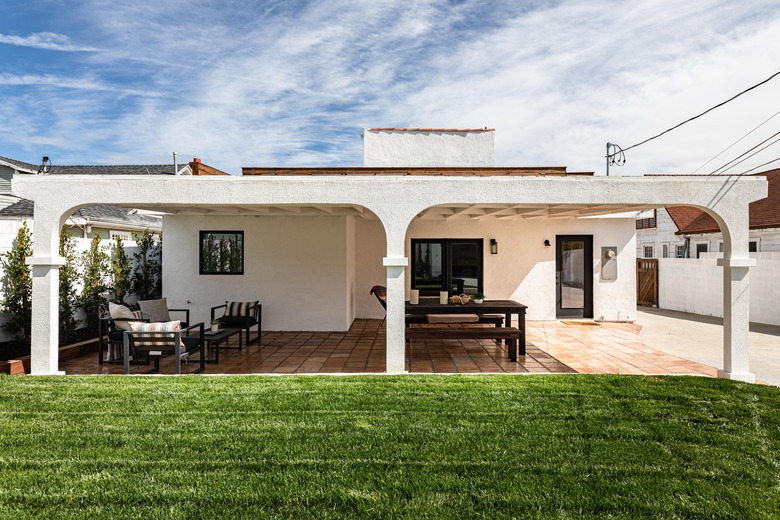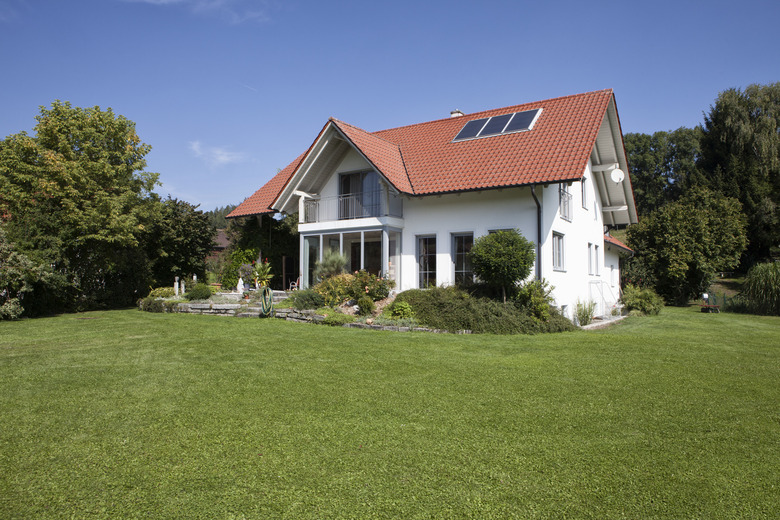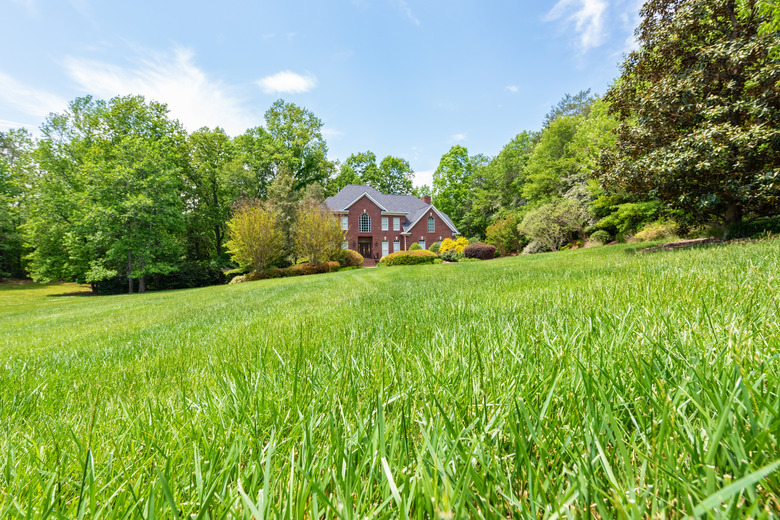How To Choose Drought-Tolerant Grasses For Your Area
We may receive a commission on purchases made from links.
Water may be the most precious commodity in the world, and today, many regions are imposing water restrictions and discouraging or forbidding the use of water for nonessential things like washing cars and watering lawns. That is one reason drought-tolerant grass species — those that can go for a long period without water — are gaining in popularity.
Creating a low-water landscape starts with choosing the right drought-tolerant lawn grasses. Pick warm-season grasses for warmer areas and cool-season grasses for others and make sure the grasses fit your family's needs. When you take the time to do that, you are likely to love your drought-tolerant grass.
Warm-Season vs. Cool-Season Grasses
Warm-Season vs. Cool-Season Grasses
If you are considering installing waterwise grasses, you'll want to be sure to pick species that work well in your region. Information about U.S. Department of Agriculture plant hardiness zones is always an important consideration, but in the case of drought-tolerant grasses, more general rules apply first.
The basic rule of thumb when it comes to selecting drought-tolerant grasses is to first determine whether you need warm-season or cool-season grasses. Warm-season grasses grow best in regions with hot summers and mild winters, like Florida, North and South Carolina, Georgia and Louisiana.
Cool-season grasses are the better bet in cooler climates. This can mean anything that is not the South, including the northern states and most of the central states. In these areas, summer is temperate, but winters are chilly. Usually, the winters will see temperatures drop below freezing quite frequently. In some in-between areas, either type of grass can do well. This can be the case in the moderate-weather belt running from Virginia and West Virginia across the continent to Southern California.
Both warm-season and cool-season grass species usually have the ability to go dormant during periods of adversity. During dormancy, the grass uses less water, giving priority to the roots while withholding water from the blades that turn brown. It is not uncommon for a turfgrass species to be able to stay dormant for three or four weeks, but the grass will revive after the dormancy if it gets sufficient water. Cool-weather grasses tend to become dormant during summer drought, which allows them to survive a limited-water period without dying.
Warm versus cool season is not the sole consideration. You'll also want to think about what you expect to do on your lawn and how much effort you want to put into maintenance. Different drought-tolerant grasses have different uses.
Drought-Tolerant Grasses for the South
Drought-Tolerant Grasses for the South
As the name "warm-season grasses" suggests, these are the best grasses for hot-summer areas. They thrive in the heat of a hot, hot summer, and they don't require much water to make it through. Not every warm-season grass is drought tolerant but many are.
Bermudagrass
If you are looking for warm-season, drought-tolerant grass, you may as well start with Bermudagrass (Cynodon dactylon, USDA zones 7-10). This is one of the most drought-tolerant of the warm-season grasses, especially the 'TexTurf' and 'Celebration' cultivars. Fans of Bermudagrass claim that a mere 1.25 inches of weekly water from rain or irrigation will keep this grass happy. That's because some of its roots sink down to 6 feet or so, depending on the soil profile (even though 80 percent or more of the root system grows in the top 6 inches of soil), giving this grass a large safety net.
Even after an extended drought, this amazing species doesn't die but goes dormant for a few weeks, waiting for water. As soon as it gets a drink, it turns green again and starts growing. One downside is how fast it does grow, requiring regular mowing. Another is that it goes dormant in winter and often needs overseeding.
St. Augustine Grass
If your lawn area gets light shade rather than full sun, St. Augustine grass (Stenotaphrum secundatum, zones 8-10) is a good option, growing well in dappled sunlight and tolerating foot traffic. Its above-ground stems, called stolons, aid in its drought tolerance, allowing the coarse grass blades to regrow in the bare patches caused by drought. The top cultivar for drought tolerance is 'Flortam.'
St. Augustine grass is a medium-green hue and stays green in winter while it is dormant. You need to limit irrigation during the winter since too much winter water often results in disease. It survives and thrives on only 1 inch of water a week. Like Bermudagrass, St. Augustine grass goes dormant after a long period of drought. That means you have almost a month to give it a drink before it dies.
Zoysia Grass
Zoysia (Zoysia spp., zones 5-10) might be the most waterwise warm-season grass of all. Some of the best drought-tolerant cultivars like 'El Toro' or 'Jamur' need only 0.05 inch of water a week. It's also popular for its good looks. As opposed to rougher, tougher drought-tolerant grasses, zoysia grass creates a soft, lush, light-green carpet. This grass invites and accepts foot traffic and works well in both sun and shade.
There has to be a downside, and for zoysia, it's the growth rate. It grows quite a bit more slowly than Bermudagrass and St. Augustine grass. On the other hand, zoysia grass boasts an expansive root system of thick rhizomes. These underground stems can repopulate bare spots in the lawn.
Bahiagrass
Bahiagrass (Paspalum notatum, zones 7-11) is a coarse grass like St. Augustine, which means it isn't likely to win fans with its looks. However, if you have poor, infertile soil in a sunny area and want a very drought-tolerant grass, bahiagrass will fit the bill. Note that you won't get a lovely, dense carpet of green, but its deep root system will keep the watering down, and traffic doesn't bother it.
Drought-Tolerant Grasses for the North
Drought-Tolerant Grasses for the North
If your summers are mild and your temperatures drop in winter, you are likely to need cool-season grasses. This may be you if you live in the northern third of the country, like New England, the High Plains, the upper Midwest or the Pacific Northwest, including Northern California. These grasses also work well for the middle third of the nation, termed the "transition zone," and particularly tall fescue, which tolerates summer heat.
Drought tolerance is a little harder to find when it comes to cool-weather grasses since many go dormant during extremely dry summers. Your best choice may be a type of fescue.
Tall Fescue
Tall fescue (Lolium arundinaceum, zones 4-7) is a standout cool-season grass that uses the water that comes its way efficiently thanks to its long roots. Its water needs are minimal; something between 0.75 and 1.25 inches of water a week keeps this coarse, bunch-type grass looking healthy. Look for the dwarf varieties for optimal drought tolerance.
If you are willing to mow tall fescue regularly, it will look like a traditional lawn. Mowed or not, this dark-green grass is extremely tolerant of foot traffic. It also tolerates heat and shade and can stay green all year in some climates. That makes it a good choice for homeowners in the "transition belt" who want green turf in the wintertime.
The transition zone includes the states in the middle third of the country below the upper third in the North, where only cool-season grasses grow, and above the lower third in the South, where only warm-season grasses grow. The transition zone includes parts of central California, the northern sections of Arizona, New Mexico, Texas, Mississippi, Alabama and Georgia as well as the southern sections of Nevada, Utah, Colorado, Kansas, Illinois, Indiana, Kentucky, West Virginia and Pennsylvania and the states in between.
One consideration is that each fescue grass plant grows from its own individual seed. That means you have to seed heavily to get a lawn-like look. Also, the grass doesn't spread easily.
Fine Fescue
Fine fescue (Festuca spp., zones 3-7) has three critical attributes that attract homeowners: drought resistance, easy maintenance and shade tolerance. All fine fescues have very low water needs, starting at 0.75 to 1 inch of water weekly. The thick underground rhizomes self-repair the lawn if it is drought damaged. Two types of fine fescue that are known for their drought resistance are creeping red fescue (Festuca rubra) and Chewing's fescue (Festuca rubra subsp. commutata).
Fine fescues are happy in most soils. They thrive in well-drained, sandy, acidic soils but are also happy in clay soil with good drainage.
Sheep Fescue
Sheep fescue (Festuca ovina, zones 3-7) is an exceptional type of fine fescue grass, sometimes called the Swiss army knife of the fescues since it fulfills many needs. It is the most drought tolerant of the fine fescue grasses as well as the most heat tolerant. It can be used anywhere from ski slopes to campgrounds or even your landscape, shrugging off the harshest conditions and most extreme temperature changes.
Sheep fescue is a bunch grass that grows in clumps, offering a wild or natural look. You won't need to water much or mow often, but you won't want to play volleyball on it either. It works best in areas that are not used for backyard activities.
Kentucky Bluegrass
As you probably guessed, the flat, narrow blades of Kentucky bluegrass (Poa pratensis, zones 3-7) are often a striking blue-green shade, but that doesn't mean they are needy. This grass will be happy on 1.5 inches of water a week. The most drought-tolerant varieties include 'America,' 'Apollo,' 'Baroness,' 'Brilliant,' 'Impact,' 'Mallard,' 'Midnight,' 'Midnight II,' 'Moonlight,' 'Rugby II,' 'Showcase,' 'Total Eclipse' and 'Unique.'
Kentucky bluegrass grows from underground rhizomes that are self-repair experts. They creep over to fill in any bare spots in the lawn. On the other hand, this grass will go dormant faster than others if it experiences periods of extreme drought.
Buffalograss
This drought-tolerant grass needs only 0.25 inches of water a week. A Midwest native, buffalograss (Buchloe dactyloides, zones 4-8) is admired for its hardiness and easy maintenance as well as its lush turf. If you must mow, you should mow high, letting the grass stand at least 5 inches tall.
One downside of buffalograss involves its growth rate. It starts extremely slowly from seed, so most people installing it invest in plugs that are planted some 5 inches apart, a time-consuming way to put in a lawn. In addition, like sheep fescue, it isn't very user friendly. Its bumpy surface makes it inhospitable for backyard activities.
Promoting a Drought-Tolerant Lawn
Promoting a Drought-Tolerant Lawn
It's important to remember that picking drought-tolerant turfgrass is only one step toward creating and nurturing a drought-tolerant lawn. You need to use the best cultural practices in order to make a drought-tolerant lawn a reality. What does this mean? Cultural practices that promote these kinds of waterwise turfgrass include the soil, the way you water the lawn and how you mow it.
Deep, infrequent watering is the key. Drought-tolerant grasses usually have deep roots, so when you water, you want those roots to get deep drinks. A surface splash won't accomplish this. Use a soaker hose for smaller areas and an impact sprinkler on a tripod for larger lawns or a regular hose, taking your time. The frequency of irrigation required will depend on the grass type and the climate.
Good, fertile soil helps a turfgrass get by with less water. That's because soil with a high organic content holds on to moisture, while infertile soil just lets the water run through. It is best to work organic material like compost into the soil before planting grass. If your lawn is already in place, you can top-dress with good topsoil or a topsoil/compost mix.
Finally, mow your grass less often and leave it longer rather than shorter. Don't get out the mower more often than necessary since cutting stresses turf, especially in times of drought.
Never cut more than one-third of the height of the grass in any one mowing. If there is a species-appropriate height, use it, but if not, leave the grass a couple of inches longer than you might normally. That allows the grass blades to provide shade to their own roots, preventing too-quick evaporation. Don't forget to leave those clippings where they fall; they will decompose and add moisture to the soil.
Finally, plant your lawn at the optimal time. Cool-season grasses do best when planted in early fall, but spring is also acceptable. Don't plant when it's too hot or cold. Warm-season grasses can also be seeded in spring or early summer.
References
- Scotts: Drought-Tolerant Lawn Grasses
- Nature's Seed: My Experience Using Sheep Fescue as an Alternative Lawn Grass
- Colorado State University Extension: Modern Bluegrass Varieties for Better Heat Tolerance and Drought Resistance
- Washington State University Spokane County Extension: Grasses for Unwatered Areas
- Scotts: What Are Cool Season Grasses?



